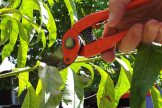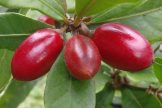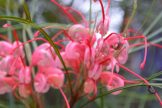
Pruning berries
General rules: Always use sharp secateurs and wipe secateurs down with Methylated Spirits before pruning each bush. This prevents any disease transferring between plants.
Cane Berries
Annual pruning keeps your cane berries vigorous and prevents the canes becoming congested and less productive. Berry patches can rapidly get out of hand if not annually pruned.
Raspberry varieties fall into two categories: summer and autumn fruiting.
Loganberries, Youngberries, Tayberries, Marionberries and other bramble type berries as well as summer fruiting raspberries grow on long canes that shoot from the base. These are best grown in rows and given a wire support, the trellis may consist of two or three wires positioned about 50cm apart, strung securely between two sturdy posts.
The first year’s canes (Primocanes) are vigorous and are best left unpruned or tip prune in winter to a suitable length (approx. 1.5m). In the second year these canes are now called floricanes and produce short laterals in spring on which the flowers and fruit are borne. After your summer harvest prune these old canes to the base as they will produce little or no fruit the following season. It is easy to pick the old canes as you move along at ground level, they are the older brown canes, and the primocanes are the fresh green ones). This encourages new canes to shoot up and produce fruit. Then go along and thin out any excess primocanes – weak ones, overcrowded ones and ones that have escaped away from the row. Tying up the remaining primocanes in bundles to the wire trellis can make them easier to manage.
Dual crop cultivars such as the raspberries Williamette, Nootka and Chilcotin will produce a smaller autumn harvest on the tips of the primocanes and these can be trimmed to just below the fruit after harvest.
Autumn fruiting raspberries fruit on the primocane tips, they can simply be cut back to ground level every winter and the new spring canes tied up as they grow. They tend to sucker – remove suckers if they spread too far away from the trellis.
Shrub Berries
Blueberries are a suckering shrub that fruits on one two and three year old laterals. After this the branch becomes unproductive and may die back. Therefore pruning takes out these older suckers as well as any weak growth and encourages new healthy suckers.
Pruning
Deciduous blueberries: In the first two years remove weak and spindly growth in winter, and remove the flowers in spring to avoid fruit set. At this stage you want the plant to put its energy into its overall root and branch structure, not fruiting.
From the third year on prune each winter, keeping only the strong canes and laterals. Remove the cross growing twiggy growth and any low growth around the base – leaving lonely upright canes from the base. Select for bright coloured wood with long (at least 3 inch) laterals. Remove blotchy coloured short growth. If 1/3 to 1/2 of the wood has not been removed by the above steps, thin out the fruiting laterals and small branches until this balance has been obtained. Try to plant your blueberries a minimum of 1m apart.
Evergreen Blueberries
Young plants need very little pruning, just remove any damaged, diseased or wayward branches. On older shrubs, start with the four D approach – remove any diseased, dead, damaged or dying branches. Then remove any clearly crossing over or branches rubbing other branches. If by this point you have removed a lot of the branches you can stop, if the shrub still looks crowded, judiciously remove a few of the older branches to produce an open balanced looking shrub.
Note: If you are growing the evergreen blueberry for a dual purpose – ornamental shrub and produce, and want to retain the dense bushy look, you can prune them more lightly using an overall tip prune, and just remove any dead or diseased material.
Goji Berries
It is the first time our goji has fruited, as the new growth was pruned in previous years before having a chance to fruit (they are tip-bearers) and because the plant was still young (they start producing after 2-3 years). Now that it is established, we knew not to prune it until after fruiting and have been well rewarded.
Black Currants
Fruit forms on the young growth, so pruning is managed to promote fresh new growth. Keep in mind that you are trying to create an upright goblet shaped habit which allows light and air through. Prune older wood out in winter, leaving mostly last season’s new growth. Remove any low lying, crossing, rubbing and weak shoots, aiming to retain around 6 to 10 healthy shoots. In the 5th winter, use loppers or a pruning saw to cut out about 1/3 of the older wood at the base, trying to pick growth that is not carrying much of the important second and first year growth. This will encourage fresh new growth to appear.
Gooseberries, Red and White Currants
Gooseberries produce fruit on both one year old wood and on fruiting spurs, and currants produce on fruiting spurs. Both need initial pruning to form a shrub with a main trunk around 30cm and four to eight lateral branches.
In late winter to early spring of the first year after planting, select five or so main stems and prune them back to 15-20cm. Remove all other stems from the base. A flush of new growth will appear, let this grow, but remember you will not get fruit on this year’s growth. This will produce fruit the following year.
In the second summer shorten the new growth back to 5 leaves – do not prune the branches (5 or so) that are going to extend the main framework. Pruning back fresh growth will not reduce fruit set, as fruit is produced on the older wood – not the current season’s growth.
In winter continue with the formative pruning. The ultimate aim is to open up the bush on the inside and produce a goblet shape. Each of the stems (lateral branches) should be tip pruned, they will remain productive for around 4- 5 years, after which they should be pruned out so that a new lateral can take its place. Keep the bush open in the centre and prune to outward facing buds, or for currants to an upward facing bud*.
Older bushes: In winter initially clean up the bush by removing all dead wood, any branches which are crossing and rubbing and any low lying shoots. Then remove any branches crossing into the centre. Remove any very old stems – stems older than 5 years will not fruit, the most productive fruiting wood is about 3 years old. Now you should have just main stems (or leaders) left. Cut these back by half of the new growth from the previous season. Any side shoots need to be cut back to 2 or 3 buds.
*Note: Some cultivars tend to be very sprawling, if that is the case with your bush, because the branches tends to sprawl and grow downwards, prune to an upward facing bud.
Jostaberries
These bear fruit on year old wood and on fruiting spurs of older wood. Do not prune in its first year.
In the second year, prune in late winter. Firstly cutting out any dead, diseased, dying or damaged wood and any branches crossing over or rubbing other branches. Then looking at the cleaned up bush, cut half of the new growth back to 15cm (cutting any side shoots back to 2 or 3 buds), and leave the other half long. In the 5th winter, use loppers or a pruning saw to cut out about 1/3 of the older wood at the base, trying to pick growth that is not carrying much of the important second and first year growth. This will encourage fresh new growth to appear.





